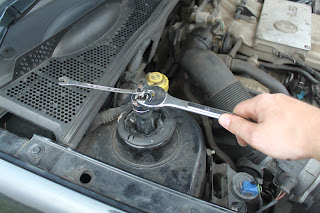Why?
There were several reasons for me choosing to make an aquarium PC. Firstly, as an experiment into long term heating effects on hardware. I have had several "always on" and gaming PCs in the past, and they only seem last a year or two before malfunctioning; whether it be the graphics card, memory or HDD at fault (despite having lots of cooling fans). I am hoping that the higher specific heat capacity of oil will facilitate a more consistent temperature throughout the PC, with the internal fans and air bubbler providing a "stirring" effect. If it turns out to be reliable and stable then I will look into building a gaming version! |
| Finished aquarium |
And lastly, as a way for me to test out the difficulty in working with new materials and tools (specifically thick acrylic) so I can apply these to other projects in the future.
There are lots of other examples on YouTube that I encourage you to take a look at. There is also a commercial desktop aquarium PC that you can buy from Puget Systems that is designed for mineral oil.
 |
| 9L Aquarium |
The main 9 litre wall mounted aquarium was purchased from a website within the UK for £100. The tank is made from glass which has been stuck together in places using what appears to be a silicone based glue. The tank is encased in an MDF frame with a gloss finish to the forward facing areas. There are two supportive glass struts at the top of the tank, on to which a glass lid is normally placed. These struts now form the main supports to the custom acrylic motherboard mounts as described below.
Inside the Aquarium
I constructed the motherboard and accessory plates from 10mm thick acrylic. This thickness is extremely rigid and will not bend when loaded with hardware. I found it very difficult to work with; a jigsaw blade generates so much heat that the acrylic reseals itself. I had to use a milling machine to cut the two rectangles in the pictures below. Drilling and tapping holes is also "interesting"; I found using rubbing alcohol whilst drilling cooled down the drill bit enough as to not melt the acrylic.
 |
| Motherboard and accessory panels |
 |
| Completed motherboard panel (with some test memory) |
 |
| Panel supporting USB Relay, Thermometer, TTL LED trigger and SSDs |
 |
| Assembled panels ready to put inside aquarium |
 |
| 5L Silicone Oil |
PC Specifications
This PC has to be energy efficient since it is always left on. I also wanted to avoid having to use an external radiator and so needed to opt for a processor with low heat output; I therefore settled on an Intel Atom based motherboard.
 |
| All of the components ready for assembly |
The specifications are as follows:
- ASRock AD525PV3 Motherboard with built-in Intel Atom D525 processor
- 4GB 1333MHz Ballistix Tracer Memory
- 2x 64GB Samsung Solid State Drives
- 205W Power Supply
Cost
Here is a breakdown of the costs (including postage). Most items are from eBay and some items are second hand.
Wall mounted aquarium
ASRock AD525PV3 Motherboard
4GB Ballistix Tracer Memory
Acrylic for motherboard base plate and I/O panel: £11.20
Shuttle Power Supply Unit
USB Wifi Dongle
SATA power splitter
NM2 nylon standoff spacers
MicroSATA to SATA adapters
64GB solid state drives
RGB LED Tape
80mm blue LED fan
40mm blue LED fan
Power switch
10L Silicone-350 Oil: £78
Bio-orb aquarium pump
Bio-orb extension cables
Silicone hose
Bubble bar
Glass suckers
4-channel usb relay
Total Cost: £482.12
Performance
Please check back to get updates on performance metrics and reliability as I measure them in due course.


















